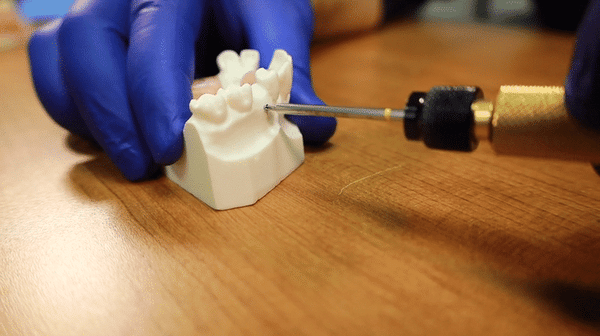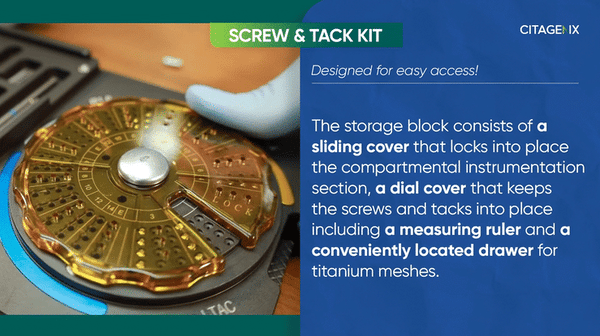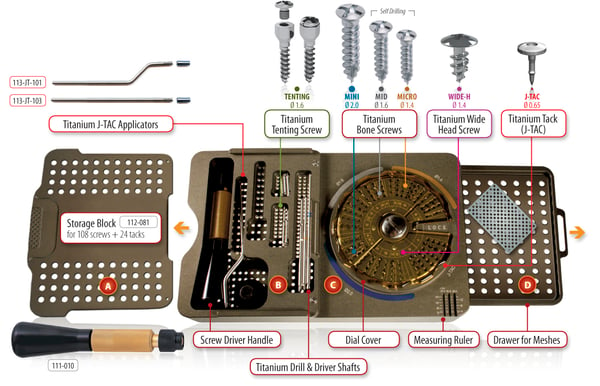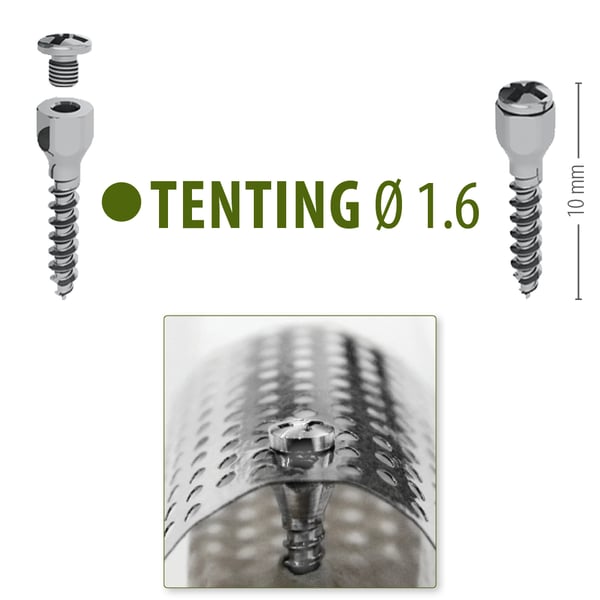Specialized instruments
Our specialized instruments offering include the popular and highly-rated Penguin RFA. We also offer a range of other specialized instruments to...
Product characteristics
Compatibilty of MulTiPegs™ and Osttell® SmartPegs
Although in principle, the two systems give the same ISQ values for an implant, they are not directly interchangeable.
If the Penguin RFA is used with Osstell® Smartpegs, the measurements need to be adjusted according to this table. If an Osstell® instrument is used with MulTiPegs™, use this table instead. This is because MulTiPegs™ and Smartpegs® are made from different materials (titanium vs. aluminum). MulTiPegs™ must be used to get the benefits of the calibrated Penguin RFA system.
Releasing tacks or screws. [Screw & Tack Kit related article]
Once your Screw or Tack is inserted, slightly tilt the Driver on any side to release the Driver. It's that simple.
Tack applicator cap usage. [Screw & Tack Kit related article]
The cap that comes with the tack applicator (regular version or offset version) is used to protect the tip from bending or opening during sterilization. Keeping the cap in place during sterilization ensures the applicator fits perfectly over the tack head and engages it when picking it up.
TIP
The cap is also handy for tacks that do not fully seat. Put the tack applicator cap on and apply pressure against the head of the tack to get it fully seated.

Product comparisons
Benefits of Penguin RFA's MulTiPegs™ over traditional pegs.
Penguin RFA uses autoclavable titanium test pegs that can be used multiple times on multiple patients. Guaranteed for a minimum of 20 uses. Other pegs are aluminum test pegs that are single use only.
ISQ values of Penguin RFA.
Penguin RFA used together with reusable MultiPeg™ gives essentially the same ISQ readings as Osstell® ISQ used with disposable SmartPegs.
However, MultiPegs™ are calibrated against a common standard, which results in comparable ISQ values between different implants. MultiPegs™ must be used to get the benefits of the calibrated system.
Product overview
The Penguin RFA, is an innovative device that helps dentists reliably and affordably measure and monitor implant stability. Here's how it works.
The Penguin RFA, is an innovative device that helps dentists reliably and affordably measure and monitor implant stability. The Penguin uses Resonance Frequency Analysis (RFA), to predictably measure implant stability providing dentists with an Implant Stability Quotient value (ISQ) to support the decision of when to restore the implant. Having accurate ISQ measurements gives clinicians confidence when determining safe loading times assessing osseointegration particularly in patients with compromised bone by recognizing if an implant might not be successful. Scientific literature on RFA indicates that an ISQ greater than 70 is considered highly stable while an ISQ less than 60 is considered low stability. Taking a baseline reading at implant placement and then, if appropriate, successive ISQ measurements during healing provides the clinician with valuable information about the integration of the implant.

The Penguin RFA is easy to use.
First, to activate the device, simply press the black control button.
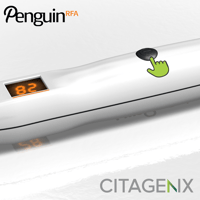
The twin displays will light up with two dashes indicating that the unit is ready to take a measurement. With the MulTipeg™ threaded into the implant, with a provided driver, the operator holds the Penguin RFA at an angle near the tip of the MulTipeg™. A signal from the instrument tip causes a magnet inside the MulTipeg™ to resonate a frequency, which is detected by the unit.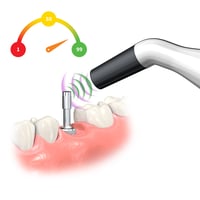
The resulting ISQ value appears immediately on both displays.
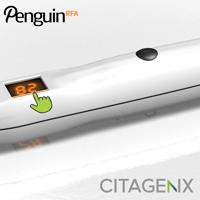
It is advisable to take at least two measurements, buccal and lingual.
There's an associated MulTipeg™ for most popular titanium and ceramic implant brands and platforms.
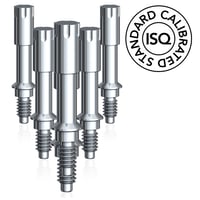
The biggest benefits the Penguin RFA provides are that it is an easy, reliable and affordable way to measure implant stability. Using scientifically backed methodology to support the clinician's decision of when to restore the implant.
Here are some of the key product highlights:
- Accurate ISQ measurement
- Easy to use
- Much lower cost than competing ISQ devices
- Reusable MulTipeg™ guaranteed for 20 autoclave cycles
- Cordless, lightweight
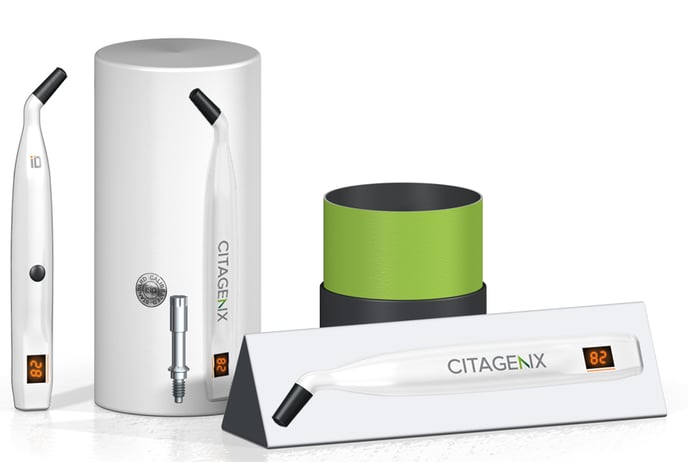
We know you'll find the Penguin RFA to be an excellent instrument that will help you become more confident in managing your implant cases.
To learn more or order your Penguin RFA implant stability monitor and MulTipegs, visit Citagenix.com or call us at 877-243-6724 (+1-450-688-2564).
Here are some helpful videos on the product
Resonance frequency analysis (RFA) provides a noninvasive, objective method of assessing implant stability over time. This technology has been studied and utilized in implant dentistry for more than 20 years and can be defined as the measurement of the frequency at which an object vibrates.
Features & Benefits
Measuring the correct length and diameter of the screws.
The bottom right corner of the full storage block has a measuring tool for each screw diameter and length. Use the Screwdriver shaft to engage the screws so that you can bring them to the measuring tool on the storage block.
Sterilization features of the Screw and Tack Kit
These autoclavable blocks are designed to organize all you need for bone and membrane fixation. Both the regular Screw & Tack Kit block and the Mini Tack Kit block are meant to be sterilized with all components enclosed.
Why use Penguin RFA's Reusable MulTipegs™?
MulTiPegs™ are made from durable titanium with sealed magnets, are re-usable and can be autoclaved to make them sterile.
They are calibrated against a reference to ensure consistent ISQ values, making it easier to compare different implant systems. The laser-marked MultiPegs™ are tissue-friendly and leave no foreign materials inside the implants.
Enhancing your decision to load your implant.
Penguin RFA measures implant stability and osseointegration to enhance decisions about when to load. Especially important when using protocols with shorter treatment times or treating high risk patients.
Penguin RFA's quick response & no contact measurement creates no stress on the healing bone.
Resonance frequency analysis (RFA) provides a noninvasive, objective method of assessing implant stability over time. This technology has been studied and utilized in implant dentistry for more than 20 years and can be defined as the measurement of the frequency at which an object vibrates.
Applications
Driving in or removing screws. [Screw & Tack Kit related article]
The latch-attachment components can be used at a very low RPM to either drive-in or remove the screws.
The use of rescue screws with the Screw & Tack Kit
The 2mm diameter screws are your 'rescue' screws if the osteotomy you performed with the 1.6mm screws is too large, or if for some reason a smaller diameter screw cannot engage properly. A larger diameter screw can be used to provide more rigid fixation.
Need pilot holes with your screws. [Screw & Tack Kit related article]
It is recommended to drill pilot holes for the 2mm screws.
NOTE
Pilot holes can also be made when utilizing screws as tenting screws or to fixate a titanium mesh or traditional membrane.
The tenting screws and the cap screws, part of the Citagenix Screw & Tack Kit, are designed to create and maintain space in bone grafting cases.
Align the top of the tenting screw body with the desired height of your membrane placement. The screw threads should be a minimum of 2-3mm into the recipient’s bone to be properly engaged. Back-fill with grafting material to height of the tenting screw body. Place the membrane (with pilot holes) and align the screw head opening. Place the tenting screw head into tenting screw body while stabilizing the membrane.
Clinical studies
Support material that is available for the Penguin RFA.
Penguin RFA has been developed by the original developers of the Osstell® device. As much research on ISQ and Resonance Frequency Analysis applies to Penguin RFA as Osstell®. You can also click links to the IDS Penguin website section with links to studies and the calibration study.
It is known that several factors affect the ISQ values, and there are sometimes questions about if MulTipeg™ tightening torque is one of them.
Naturally, if the MulTipeg is not fully secured to the implant, an error could occur in the ISQ reading.
Recently, Pelegrine et.al published the following study “Can Finger-Generated Force Be Used Reliably to Connect the Transducer for Resonance Frequency Analysis in Determining Implant Stability?” in order to determine the minimum torque required to attach the MulTipeg to the implant to measure the implant stability quotient (ISQ) and to estimate if finger-generated torque would be reliable for this purpose.
An in vitro controlled model experiment was designed to measure the torques needed to tighten the MulTipeg to the implant to produce accurate and reproducible ISQ measurements. In a previous study, it was observed that torques between 10 and 17 Ncm are adequate for precise analysis of implant stability when using Smartpegs together with an Osstell RFA instrument. However, for the Penguin RFA instrument, no such studies were available for comparison. The present study was designed to answer two questions: “Should the same torque-tightening protocol be used for both instruments (Penguin and Osstell) to produce comparable results?” and “Are finger-generated torque tightening forces sufficient to achieve accurate measurements?”
Pelegrine et.al evaluated the minimum torque necessary to insert the MulTipeg into the implant to obtain accurate stability measurements, by inserting 100 implants into a uniform polyurethane block. MulTipegs were manually attached by either female or male operators using the standard connector provided by the manufacturer. In addition, MulTipegs were also placed using a connector adapted to a digital torque wrench with different torque settings.
The stability was measured for all groups using both the Osstell and the Penguin resonance frequency analyzers. The minimum, medium, and maximum finger grip torque were accessed on 100 volunteers.
For an accurate measurement of ISQ, the minimum torque necessary to insert the MulTipeg into the implant for Penguin was 5 Ncm. Therefore, when using Penguin, the maximum finger-generated tightening force is enough.
The male digital force was statistically higher than the female, but both groups reached sufficient force to tighten the Penguin MulTipeg to 5 Ncm.
This text is a summary of recent publication: Pelegrine AA, Kubo FMM, Salatti DB, Teixeira ML, Moshaverinia A, Moy PK. Can Finger-Generated Force Be Used Reliably to Connect the Transducer for Resonance Frequency Analysis in Determining Implant Stability? Int J Oral Maxillofac Implants. 2020 Nov/Dec;35(6):1141-1148. doi: 10.11607/jomi.8305. PMID: 33270054.
The Penguin RFA MulTipegs are sensible measuring devices made in titanium with sealed magnets, which makes them reusable.
The Penguin RFA MulTipegs are autoclavable (20 cycles), laser marked with type number, have optimal platform fit and are ISQ Standard Calibrated™. The MulTipeg Driver is made of stainless steel and works like a screwdriver and a carrier for the MulTipeg. Since the MulTipeg has a magnet in its top it will attach safely inside the Driver.
As per the Penguin RFA Manual; The MulTipeg is mounted onto the implant by using the MulTipeg Driver. Use hand-tightening with 6-8 Ncm of tightening torque.
ISQ Standard Calibrated™
The peg-implant connection is a potential source of erroneous measurements due to possible misfit. Therefore, MulTipegs™ are designed to achieve the best possible fit with each implant type.
All MulTipegs™ types are calibrated against the ISQ Standard to detect any misfit or variance in ISQ, which in turn can be eliminated by elaborating the physical properties of the peg.
Another issue is that modern bone-level implants often use an internal connection for abutments and prosthetic devices. That is why some marginal bone overgrowth of the implant does not prevent a good fit. The MulTipegs™ are designed to bypass and avoid interaction with the marginal bone in order to prevent erroneous measurements.



